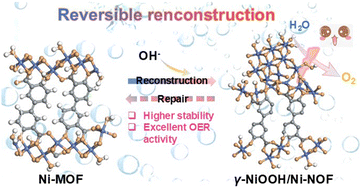Metal–organic frameworks (MOFs) are regarded as prospective electrocatalysts for the oxygen evolution reaction (OER). Nevertheless, controllably reversible reconstruction of MOFs, yielding highly active catalytic sites for durable OER, has not been extensively studied. Herein, Ni-BPM (BPM = 4,4′-dihydroxybiphenyl-3,3′-dicarboxylic acid) equipped with open metal sites was selected as a potential electrocatalyst, and orientated MOF electrodes were fabricated via a sacrificial lattice-matched-template method. Surface reconstruction of Ni-BPM to active γ-NiOOH was detected during the OER, and reconstructed Ni-BPM can also be repaired in the reduction process, resulting in durable OER properties: continuous operation at 100 mA cm−2 for 130 h followed by another 70 h at 500 mA cm−2, surpassing those of most single Ni-based catalysts. The electronic configuration transformation of Ni sites at the interface of Ni-BPM and γ-NiOOH is confirmed using in situ Raman and X-ray absorption spectra together with density functional theory (DFT) calculations. This work has investigated the reversible structural transformation of MOFs during the OER and thereby would help establish a theoretical foundation for the development of durable MOF electrocatalysts.


